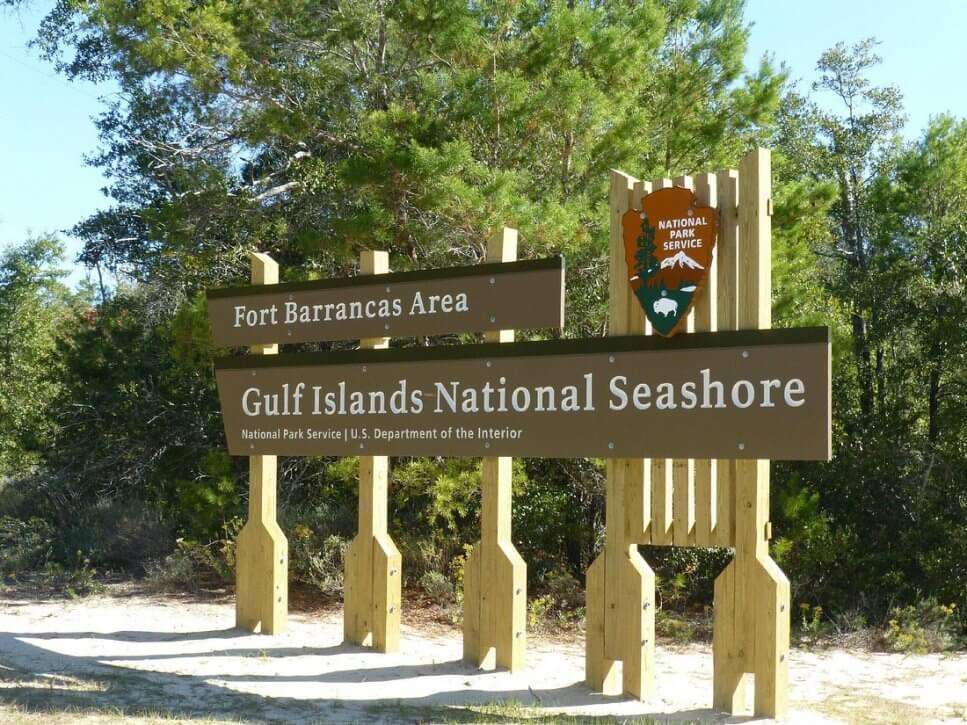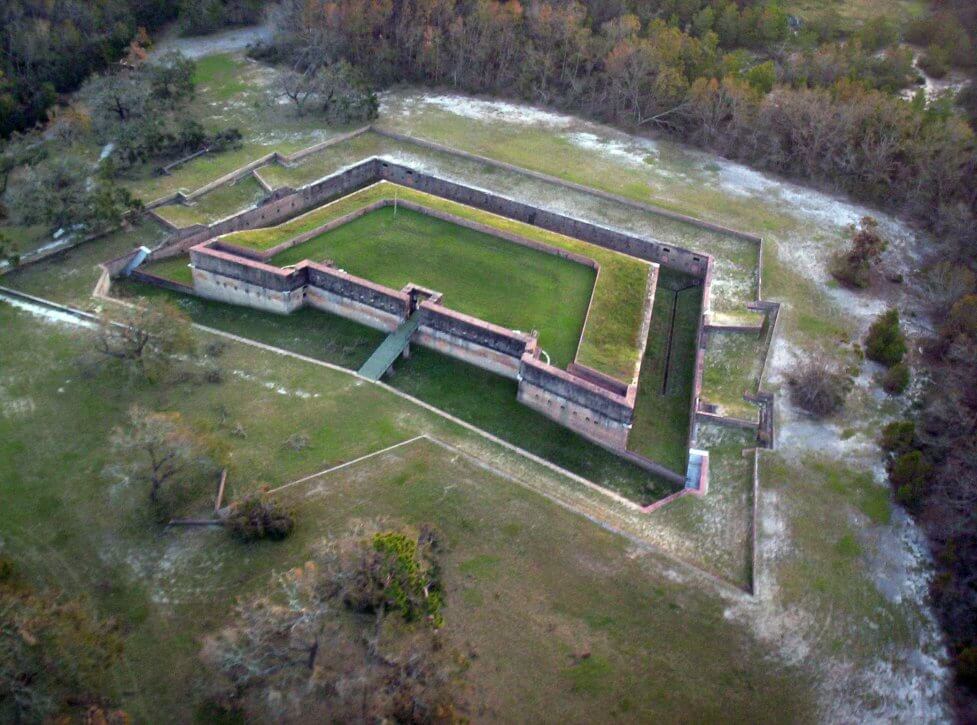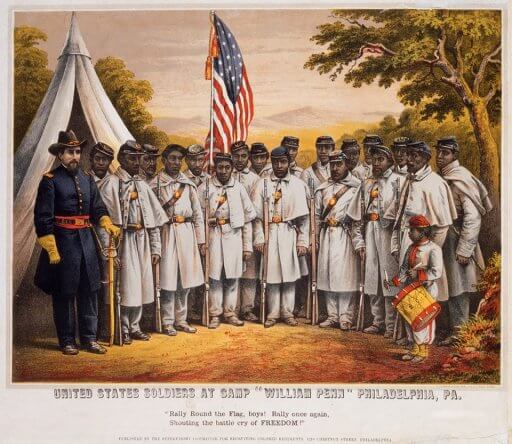by Dakota Parks

Every year, researchers uncover never-before-seen or analyzed documents, artifacts and correspondence that help us better understand landmark historical periods, such as the American Civil War, fought in part right here in Northwest Florida. Through new research brought to light, the 64-acre Fort Barrancas Area, located on the Pensacola Naval Air Station and managed by Gulf Islands National Seashore, has been officially recognized as a site on the Underground Railroad, joining nearly 700 sites, programs and facilities on the National Park Service’s National Underground Railroad Network to Freedom. Contrary to misconception, the network does not refer to a physical subterranean railroad structure, instead the Underground Railroad refers to the network of routes, safe houses and people, both African American and white, that aided enslaved African Americans in their escape to freedom. This national designation helps honor, preserve and promote the history of the black freedom struggle and the resistance to slavery in the United States.
In March 2020, Gulf Islands National Seashore Park Ranger, Casimer Rosiecki began researching and uncovering the history of the Underground Railroad site at Fort Pickens, leading to its official designation as a site on the network in September 2020. Through compiling and analyzing official correspondences and reports written by Union and Confederate soldiers, newspaper clippings and even soldiers’ diaries and letters, Rosiecki began to uncover additional accounts of freedom seekers entering the Union camp at Fort Barrancas.
When asked why it has taken so long for Fort Pickens and the Fort Barrancas Area to be recognized as sites on the Underground Railroad, Rosiecki explained that the history has gone largely untapped. “The subject of the Underground Railroad hasn’t received a lot of attention from academic historians, but that is slowly changing,” he said. “I think the continuous use of the landscape by the U.S. Military also didn’t provide public or academic historians with the means to investigate the stories related to those areas. This is just one example of how new research is uncovering these really powerful and complex stories about enslaved black people playing active roles in their liberation and their emancipation.”

The Fort Barrancas Area includes three historic structures: The Spanish Water Battery, Advanced Redoubt and Fort Barrancas. Completed in 1844, the Army Corps of Engineers built Fort Barrancas over the ruins of other forts built by the Spanish and British as early as the 18th century. Although Fort Barrancas was built to stop any foreign invasion and provided defense for the Pensacola Navy Yard, the only time the fort saw actual combat was during the American Civil War, where it operated as a Union camp, as well as a site for freedom seekers and a post for the United States Colored Troops that actively fought against the Confederacy. Although the Barrancas area played a vital role in dismantling slavery, Rosiecki explained that Fort Barrancas, Fort Pickens and the Pensacola Navy Yard were built by the forced labor of African Americans.
“Many Americans have one singular idea of whatslavery looked like prior to the Civil War. While the majority of enslaved people in the south were forced into labor on cotton plantations and in agriculture, in cities and urban areas, slavery took on different forms such as domestic labor and slave renting,” Rosiecki said. “In the mid-1820s, when the Pensacola Navy Yard was established, the U.S. Navy turned to enslavers and posted advertisements in the local paper calling on slaveholders to rent out their slaves to the federal government to build the Navy Yard. The Army Corps of Engineers also used slave renting to construct the string of Army forts in West Florida. Decades after their completion, [the forts] became the gateways to freedom seekers who were playing an active role to dismantle slavery in the United States. So, they’re both the products and the consequences of the enslavement of black people here in the United States, but [the forts] also become the tools to dismantle that institution itself.”
“The forts became the gateways to freedom seekers who were playing an active role to dismantle slavery in the United States.”
Gulf Islands National Seashore Park Ranger, Casimer Rosiecki
In his research, Rosiecki discovered two accounts written by a Union General, which documented en-slaved men of color crossing Union lines and finding refuge at the Barrancas in December 1863 and April 1864. Although the Confederate soldiers evacuated Pensacola fully by May 1862, these freedom seekers trekked hundreds of miles from plantations in rural Alabama to escape bondage. It is in this letter from the Union General in December 1863 that first mentions a freedom seeker who arrived at the Barrancas with an iron bar riveted around their leg. Through the research of an anti-slavery newspaper called the Green Mountain Freeman, based in Vermont, Rosiecki uncovered an anonymous article chronicling Henry’s struggle for freedom. Although the editor kept the contributor’s identity hidden, the article signs off saying, “Yours for Union and Universal Freedom.”

“From this newspaper, we learn that Henry’s struggle for freedom began around August 1863.” Rosiecki explained. “Henry resisted his enslaver and made his way to Pensacola, where he lived in an abandoned structure for two weeks before he was captured by 15 Confederate soldiers. They tortured him and forced him back to his enslavers in Sparta, Alabama. The 1860 census records indicate his enslavers were James and Mary Burnett, who enslaved about 40 people of color. When Henry was returned to the Burnett plantation, his enslavers riveted a modified tire iron tightly around Henry’s right ankle, which formed a hook at the bottom of his foot to keep him from being able to walk properly. In mid-November 1863, Henry again escapes and makes the 100-mile trek from Sparta to Pensacola through swamps, nearly drowning once and still dragging this iron torture device along with each painful step before he finally arrives at the Barrancas.”
Once Henry arrived at the Barrancas in December 1863, Union soldiers spent 30 minutes working to successfully remove the torture device from his ankle. The historical record indicates that Henry went on to become a Union soldier, serving in the 14th Regiment, Corps d’Afrique, which organized out of New Orleans and was later renamed the 86th United States Colored Troops. Rosiecki then used this information to uncover an enlistment form for a man named Henry Stalburt that matched the exact date of the Union General’s report of a man entering Union lines at Barrancas with an iron bar around his leg. Henry Stalburt was around 30 years of age, listed his occupation as a laborer and signed the form with an X for his signature.
“Military records show that Henry survived his service, mustering out in September 1865 for medical reasons” Rosiecki continued. “His regiment played a vital role in the Civil War through various expeditions in West Florida and South Alabama. One significant expedition from Barrancas to Marianna in Jackson County, FL in September 1864, resulted in the liberation of around 600 men, women and children. By the end of the Civil War, around 200,000 men of color fought for the Union. Historians show that approximately 180,000 served in the US Army in the United States Colored Troops, and a slight majority were formerly enslaved men.”
Rosiecki’s research and uncovered stories not only led to the official recognition of Fort Pickens and the Fort Barrancas Area as sites on the National Park Service’s National Underground Railroad Network to Freedom, but will also be available to future interpreters, educators and generations to come. Although there are no current plans for an official exhibit or public tour based on the new findings, the research will be readily available when the time comes for future exhibits, tours or demonstrations. While Fort Pickens is open to the public to visit and explore, Fort Barrancas Area, located on the Pensacola Naval Air Station remains closed to the public. Visit nps.gov/guis/learn/historyculture/fort-barrancas.htm to learn more about Fort Barrancas and for updates on re-openings.
“History can be difficult,” Rosiecki said. “Often these authentic stories may not portray our country in the way we think it should be portrayed, but we need a complete narrative that is not tilted or biased to only show good stories. These stories are not mine—they are the property of the American people—people here today and future generations. I think it’s incredible to immerse yourself in these places and to look at the rise and fall of slavery here in our nation. We can chronicle that story here on the Gulf Coast at Gulf Islands National Seashore.”